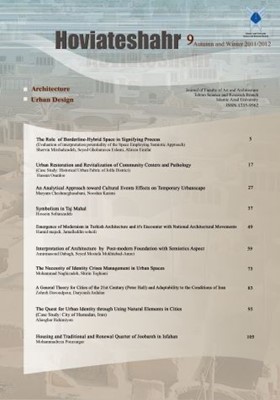Urban Restoration and Revitalization of Community Centers and Pathology of Historical Urban Fabric of Jolfa District
Subject Areas : architecture
1 - , Assistant Professor, Faculty of Architecture, Soore University
Keywords:
Abstract :
The District of Jolfa is indicative of one of the most important period of history and rich culture of Iran particularly in the period of the Safavid. with its splendid artifacts coinciding with the empire of Charles V in the west and the reign of Suleiman the Magnificent (XVI) the Ottoman emperor in the Middle East. The Armenian community in Jolfa lived on small businesses and handicrafts activities. This led to a very lively and active social enlivening of the streets and buildings with many shops and places of worship and gathering. Therefore, the urban structure of the region was characterized by the density of social relations and productive exchange among the inhabitants that have been maintained over time. This research applies to the Armenian quarter of Jolfa where the remainders of the Armenian community of Isfahan still live. The district currently has faced problems in relation to cultural heritage conservation and the environment protection due to ongoing urban transformations. It, therefore, undertakes an analytical approach to the urban and architectural district, where still there are beautiful buildings, court houses, residences made of elegant clays, brick and stone, constructed over a long period of time from the beginning of the 1500s till the end of 1900s. The research applies primarily to the study of the historical formation of the district in the broader context of social, urban and regional policies in early Safavids era, followed by the analysis of the settlement morphologies of an ethnic minority in a Muslim city within its social, cultural and human context and their impacts on local Armenian community. The research also elaborates on the needs for a series of restoration and construction activities as well as revival of historic routes in the city. The potential strengths and weaknesses in the current Julfa area are reviewed and preliminary action plan for the implementation of solutions in relation to issues such as urban rehabilitation, reintegration, restructuration, consolidation and protection are addressed. In this context consideration of the elements and pathways, urban routes and communication networks, identification and location of historical monuments , nodes of the infrastructure networks, landmark signs and urban areas, formative elements of morphology, spot facts relating to particular areas are essentially important in the restoration projects of the district of Julfa. Normally the analysis of an urban area or part of a city is undertaken through series of statistical analysis applied to quantitative topographical distribution of different living functions (residential services, infrastructure, etc.) in the settlement formation. Such analysis does not give us the possibility to experience directly the long time process that led to the current situation being the result of an initial established plan and its successive transformations. The process can be reconstructed by working up it gradually to present situation. This can lead us to the past through making use of a character analysis and critical interpretation. Analysis of some fundamental variables such as: out skirt of the city, roads and waterways, residential types, monumental buildings and public places have been taken into consideration.
_||_

